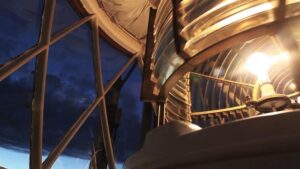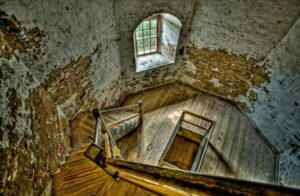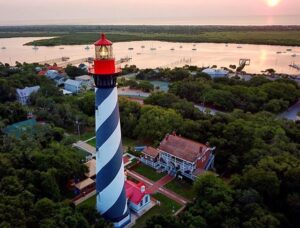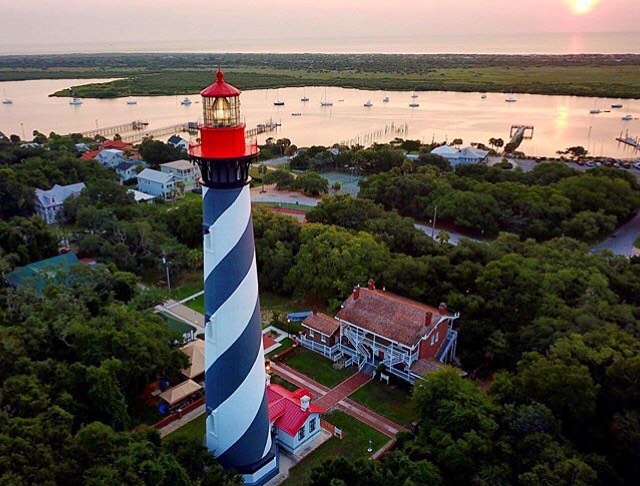Today’s technology can guide a 560´ Ohio-class submarine with a submerged displacement of 18,750 tons effortlessly through the ocean depths with remarkable accuracy. But what about navigation during the time when our world was being explored by those eager pioneers? The Mayflower, which carried our pilgrims from England, is estimated to have been about 90´ long with a weight of 180 tons. We can only imagine the perils they faced crossing oceans in wooden ships powered only by the wind. And when they reached shores far from home, how many ran aground or perished in the dark of night because they only had moonlight to guide them.
 As eastern civilizations expanded and populations grew, farmers, traders, capitalists, and dreamers went in search of new ground and upon their arrival in this vast new world, it became obvious that a new navigational tool was needed along the meandering coastlines. The lighthouse was born and, in time, the new country was populated by a network of lighthouses along the oceans and the Great Lakes.
As eastern civilizations expanded and populations grew, farmers, traders, capitalists, and dreamers went in search of new ground and upon their arrival in this vast new world, it became obvious that a new navigational tool was needed along the meandering coastlines. The lighthouse was born and, in time, the new country was populated by a network of lighthouses along the oceans and the Great Lakes.

One of my favorites is the St. Augustine Lighthouse in Florida. It is an active, working lighthouse located on Anastasia Island and its black and white stripes identify it to everyone who is familiar with the system of markings devised so that sailors could pinpoint their location in daylight. On one of our visits to St. Augustine, Ken talked me into climbing the lighthouse stairs. Understand, please, that I am “blessed” with a fear of heights and I know I have lots of company in that regard. My fear is not severe enough to be considered acrophobia but I still get a healthy jolt when I’m more than about 10-15 feet off the ground. It has kept me from experiencing some adventures that I really would have enjoyed had I been able to overcome it. Making matters worse, this lighthouse has a spiral staircase made of beautiful open-worked steel which meant I could always see to the bottom. This did nothing to inspire my confidence but I was determined not to chicken out. At the top, my legs felt like rubber but the exhilaration I felt when we shared that phenomenal view of the city and the open water made it all worthwhile and I wouldn’t trade that moment for anything.
My imagination has explored the topic of lighthouses on several occasions and this week turned out to be perfectly timed (another of those God things) because Pastor Dennis spoke to us recently about the darkness in our world. We are surrounded by darkness everywhere we turn but we don’t have to allow fear to consume our future.
Jesus spoke to the people again, saying, “I am the light of the world. Whoever follows me won’t
walk in darkness but will have the light of life.” John 8:12 CEB
We can carry the Light into our world!
There’s a Southern Gospel song, The Lighthouse, written in 1970 by Ronny Hinson, that some of you may recognize. Its words portray our choices vividly:
There’s a lighthouse on the hillside that overlooks life’s sea.
When I’m tossed it sends out a light that I might see.
And the light that shines in darkness now will safely lead me home.
If it wasn’t for the lighthouse, my ship would sail no more.
Everyone that lives around us says tear that old lighthouse down.
The big ships don’t sail this way anymore, ain’t no use in it standin’ round.
But my mind goes back to that stormy night when just in time I saw the light
With the light from that old lighthouse, that stands there on the hill.
Chorus:
And I thank God for the lighthouse, I owe my life to Him.
Jesus is the Lighthouse and from the rocks of sin,
He has shown the light around me so that I might clearly see.
If it wasn’t for The Lighthouse (tell me) where would this ship be?
The Bible is God’s chart for you to steer by, to keep you from the bottom of the sea, and to show you
where the harbor is, and how to reach it without running on rocks or bars. Henry Ward Beecher



Thanks Marcy, and Happy Birthday to you. Hope it was adventurous. Love ya. Linda
The song was very inspirational.
thank you,❤